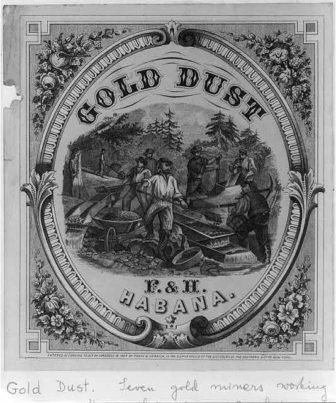History of Gold in Alabama

Tobacco label showing seven gold miners working around three sluice ways, washing auriferous earth. Created / Published c1867.
The first major gold strike in Alabama occurred in 1830 at Blue Creek (Ripatoe Placer), a creek on Lake Mitchell near Clanton, Alabama, and Chestnut Creek.
Significant gold discoveries continued throughout the coming years. Gold has been found throughout Talladega, Tallapoosa, Chambers, Coosa, Clay, Chilton, Elmore, Cleburne, and Randolph Counties. Gold is still being found in Alabama, mostly in the form of lode gold mining, also called hard rock mining and placer gold found in soils and gravel.
Placer mining can be done by a lone prospector filling a pan with crushed ore or scooped sediment and washing away all but the fragments of placer gold. Lode mining requires a number of workers to remove ore, crush the ore and extract the gold from the ore.
1916 Bulletin of the Geological Survey of Alabama:
GOLD AND SILVER
By James M. Hill.
IN 1916 there were mined in Alabama 418.44 ounces of gold, valued at $8,650, and 53 ounces of silver, valued at $35, an increase of 164.81 ounces of gold and of 41 ounces of silver in 1916 over 1915. The production in 1916 came from 3 placer mines and 2 deep mines in Chilton, Cleburne, Talladega, and Tallapoosa counties, as compared with 2 placers and 1 deep mine in 1915. There were 11,063 tons of ore treated by amalgamation at the two deep mines in operation, the greater part being from Tallapoosa County.
The discovery of lead ore is reported near Jamestown, Cherokee County, and near Huntsville, Marshall County.
Other details concerning the Gold and Silver production in Alabama may be seen in the tables following:
Mine production of (/old and silver in Alabama in 1916.
Mine production of gold and silrcr in Alabama in 1916, by sources, in fine ounces.
Fuller accounts of the occurrences and former activities in the mining and milling of gold and silver in Alabama will be found in our statistical reports for 1914 and 1915.
Additional Resources
Paris, T,A, 1985, The Goldville project—Results from an exploration project for gold in the northern Alabama Piedmont, in Misra, K.C., ed., Volcanogenic sulfide and precious metal mineralization in the southern Appalachians: University of Tennessee, Studies in Geology 16, p. 182–205.